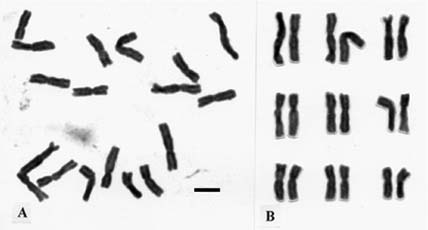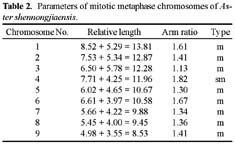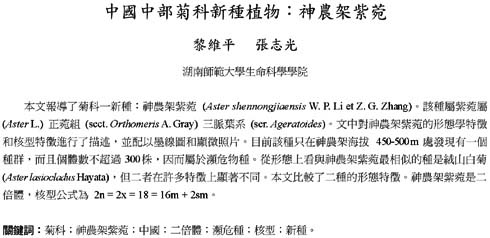Bot. Bull. Acad. Sin. (2004) 45: 95-99
Li and Zhang — Aster shennongjiaensis, a new species
Aster shennongjiaensis (Asteraceae), a new species from central China
Wei-Ping Li* and Zhi-Guang Zhang
College of Life Sciences, Hunan Normal University, Changsha 410081, P. R. China
(Received April 25, 2003; Accepted September 1, 2003)
Abstract. A new species of Aster (Asteraceae) from China, Aster shennongjiaensis W. P. Li et Z. G. Zhang, is described and its morphology and karyotype illustrated. Aster shennongjiaensis is apparently endangered, presently known only from one small population in bamboo forests of Shennongjia Reserve in central China. On a morphological basis, the closest species to A. shennongjiaensis is A. lasiocladus Hayata, but they are quite different in many features. The morphological characteristics of the two species are compared. Karyotype of the new species is described and formulated as 2n = 2x = 18 = 16m + 2sm.
Keywords: Asteraceae; Aster shennongjiaensis; China; Diploid; Endangered species; Karyotype; New species.
Introduction
Shennongjia, a Biosphere Reserve of central China, is situated between longitude 109°56'-110°58' E and latitude 31°15'-31°57' N. This area has an archaic geological history, a complex and isolated topography, and complex climatic conditions. The mean elevation is 1,700 m, the annual mean temperature 10-12 °C, and the annual precipitation about 1,200 mm. An extremely diverse vascular flora inhabits this reserve with 2,638 species and infraspecific taxa belonging to 850 genera and 193 families (Zheng, 1993), making the reserve one of the three richest regions of plant diversity in China and a Biosphere Reserve.
During botanical exploration and conservation studies in Shennongjia Reserve in 1997, we collected an unknown taxon assignable to the genus Aster. After further field observations and collections and thorough consultation of Flora Reipublicae Popularis Sinicae (Ling and Chen, 1985), Plantae Sinenses (Handel-Mazzetti, 1938), Flora of Japan (Ito and Soejima, 1995), and Flora of Taiwan (Soejima and Peng, 1998a), and after comparisons with the herbarium specimens of Aster species in the PE, WUK, SZ, CDBI, HNNU, KUN, IBSC, IBK, NAS, HGAS, CCNU, HIB, HIMC, and FUS herbaria, we concluded that the taxon is a new species of the series Ageratoides (Asteraceae, Aster L., sect. Orthomeris A. Gray).
The series Ageratoides Kitam. is distributed mainly in East Asia (Ling and Chen, 1985). On the Chinese mainland, the series is represented by ten species (Ling and Chen,
1985; Soejima and Peng, 1998a), among which seven are endemic, that is, Aster homochlamydeus Hand.-Mazz., A. menelii Levl., A. alatipes Hemsl., A. dolichophyllus Ling, A. hunanensis Hand.-Mazz., A. limosus Hemsl., and A. moupinensis (Franch.) Hand.-Mazz.. The last five species are restricted to central China, and this is, therefore, one of centers of the series for speciation.
Materials and Methods
Field observations and collections were made four times respectively on 10 July 1997, 29-30 July 2000, 28-29 October 2000, and 14-15 September 2001 in Shennongjia Reserve, Hubei Province in central China. We collected 35 individuals of the new species, among which 25 were prepared for morphological analysis as specimens that were deposited in the Herbarium of Hunnan Normal University (HNNU), and 10 were cultivated at Hunan Normal University to be used for cytological investigations.
Actively growing root tips 5 mm long were cut and pretreated with 0.1% colchicine at about 20°C for 4 h before being fixed in Carnoy I (glacial acetic acid: 95% ethanol = 1:3) at 5°C for 12 h, then macerated in a 1:1 mixture of 1 mol/L hydrochloric acid and 45% acetic acid at 60°C for 2 min, and finally stained and squashed in 1% aceto-orcein.
The karyotype parameters came from the data of the chromosome characters of ten somatic metaphase cells from the ten plants. The symbols used to describe the karyotype followed Levan et al. (1964): m = median-centromeric chromosome (arm ratio: 1-1.70); sm = submedian-centromeric chromosome (arm radio: 1.71-3.00). The symmetry of karyotype was classified according to Stebbins (1971).
*Corresponding author. Tel: 86-731-8871052; Fax: 86-731-888-3310; E-mail: lwp@hunnu.edu.cn




